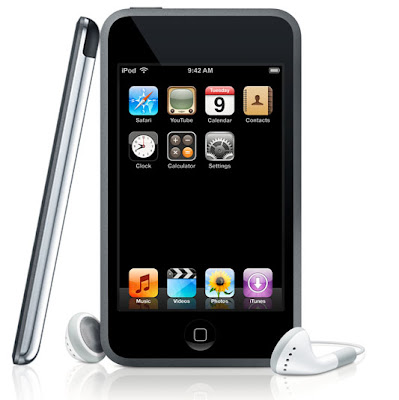
The touch is a thing of beauty. It's much skinnier than the iPhone (which, for those who haven't held one, is the same depth as the old 30GB iPod Video), and it's also a bit shorter and a hair wider, with dimensions of 4.3 by 2.4 by 0.3 inches. The touch weighs a manageable 4.2 ounces (compared with the iPhone's 4.8 ounces).
The only button on the device is the same button you'll find on the face of the iPhone. The touch's rear panel is shiny stainless steel like that of iPods past, not the brushed metallic look that iPhones have. In the upper left-hand corner of the rear panel, you'll find the black patch of plastic that houses the Wi-Fi antenna. The proprietary 30-pin iPod connection and headphone jack (which isn't recessed like the iPhone's) rest on the bottom panel, and the sleep switch rests on the top left edge of the player (when held vertically). There's no camera on the iPod touch, but that's doesn't detract much from it, since the iPhone's camera is more toy than tool. Like the iPhone, the touch has a built-in accelerometer to make possible all those view changes when the player is held horizontally.
Navigation of the music, video, and photo menus is identical on the touch and the iPhone. Similarly, the players load and sync with iTunes in much the same way. You can scroll down lists of artists, albums, and playlists when in vertical mode, or turn the player horizontally to view the excellent Cover Flow feature. For those who haven't seen it before (it's now part of iTunes and was featured on the iPhone), Cover Flow orders records alphabetically in a horizontal array, but visually, using album art. Drag your finger through the display to move the covers, as if thumbing through a virtual vinyl collection, and click on the central cover to flip the graphic over and reveal a track list. From here, you can simply click on a song and start playing. This is the coolest way to navigate a music menu I have ever seen—and it's much more effective here than it is on the new nano, which lacks the sexy multitouch screen and is less graceful in its movement of the album art. The Now Playing screen makes the album cover the main focus, filling most of the screen when vertical, and is identical to the same screen on the iPhone. When your iPod touch has finished syncing to your PC's library, you can just unplug it—none of the ejecting business that other iPods make you do (and that you inevitably forget to do once in awhile, prompting an ugly error screen on your computer).
No comments:
Post a Comment